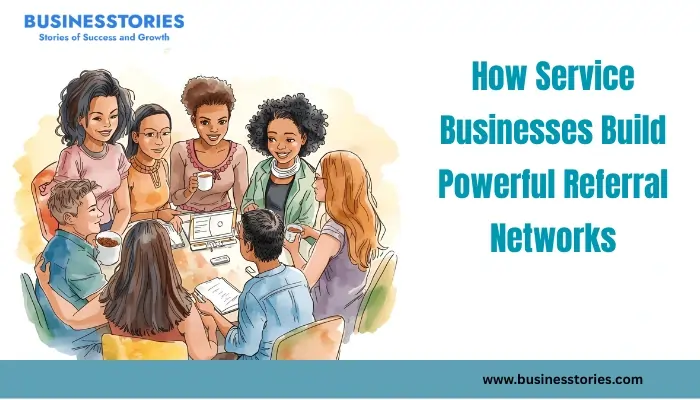What is Referral Network?
In today’s digital world, filled with online advertisements and algorithms, one marketing strategy has remained timeless — referrals. For service-based businesses, a trusted recommendation from a satisfied and happy client or partner can outperform even the most expensive marketing campaign. Such word-of-mouth promotion often brings more results than expensive advertising efforts. Discover how to build a powerful referral network for your service business. Learn strategies to attract clients, strengthen partnerships, and grow through trust, not ads.
Referrals work through trust itself, unlike ads that interrupt the customer experience. They convert faster, cost less, and build stronger client relationships. This approach itself delivers better results across all business metrics. But referral networks do not grow by accident — they are cultivated through strategy, consistency, and authentic relationships.
This guide shows you how to build a powerful referral network that becomes a steady source of qualified clients for your service business — no gimmicks, just genuine growth through people.
Understand What Makes a Referral Network Work
According to business requirements, it is essential to understand the key factors that govern referral network functioning. Simple strategies and proper relationship management make referral systems work effectively.
Referrals are the main source for most successful service businesses because they start with trust — the hardest currency to earn and the easiest to lose. When someone refers you, they are putting their reputation on the line, so your network must be built on reliability and credibility.
For most service-based entrepreneurs, ideal referrers fall into one of four groups. These groups help identify the best referral sources for business growth:
- Happy past clients who experienced outstanding results and further expressed satisfaction with the service itself.
- Complementary professionals who serve the same audience but offer different services, so they can refer business to each other without competing, such as real estate agents referring mortgage brokers, or web designers referring copywriters.
- Local business owners who interact with your target market represent the community itself.
- Community influencers or group leaders who can introduce you to potential clients at scale.
To begin, map out your referral ecosystem. This mapping will help you identify key partners and their relationships clearly. Ask yourself: Who meets my ideal client before I do? Identifying these people will help you understand the client journey better. For instance, if you run a marketing consultancy, an accountant or business coach might meet your perfect prospect first. These individuals become valuable partners in your referral network. They help you get more business connections.
Understanding this dynamic is the foundation of every successful referral strategy — because it focuses your energy where it truly counts. This approach ensures that energy is focused on the most important areas for maximum results.
Also Read: How Leap.club Helps Women Entrepreneurs Grow Their Network
Turn Referral Network Connections into Collaborations
It is easy to collect business cards or LinkedIn connections, but true referral relationships are earned through collaboration, not contact lists. People refer those they trust and remember, and building that kind of trust takes intentional effort.
Instead of chasing many connections, focus on building meaningful, mutually beneficial relationships. Attending local business events, networking breakfasts, or online communities relevant to your industry itself helps expand your professional network. But do not stop there — follow up meaningfully. Send a message after meeting someone, suggest a coffee chat, or share an article that could help their business. This simple follow-up helps build strong professional connections.
Partnerships become stronger when you add value first. Offer to write a guest post on their website, co-host a webinar, or share their social media posts. When you show genuine interest in their success, they naturally want to return the favor. This process itself creates mutual support between both parties.
A simple mental shift helps here: stop asking, “Can you send me clients?” and start asking, “How can I help you create more value for your clients?” This approach transforms you from a taker into a trusted collaborator — and trusted collaborators are always remembered when opportunities arise.
Design a Simple, Irresistible Referral Program
While many referrals happen organically, formalizing your process ensures consistency and fairness. A structured referral program communicates appreciation, sets expectations, and makes it a simple process for people to participate.
A strong program includes four key elements:
- Who can refer: Clients, partners, professionals, or followers.
- What counts as a referral: Define whether it is a qualified lead, an introduction, or a converted sale.
- What is the reward: Offer something meaningful — cash bonuses, service credits, discounts, or exclusive access.
- How you track it: Use tools like HubSpot, Zoho CRM, or even a Google Sheet to monitor referrals and rewards transparently. Moreover, these platforms help you maintain clear records of rewards and referral progress effectively.
For example, a digital agency could offer existing clients a ₹2,000 service credit or a free strategy session for every successful referral. They could also provide a free strategy session as an alternative reward option. The incentive should feel like a thank-you, not a transaction.
You can communicate it with a clear and simple message:
“Most of our clients come from referrals. If you know someone who could benefit from our services, we would love to help — and we will thank you with a special gift.”
When people understand the process and feel appreciated, they become more likely to refer further clients.
Deliver a “Referable” Experience
A referral-worthy business does not just meet customer expectations — it exceeds them. Every interaction with your clients is an opportunity to build advocacy.
To make your service truly referable, focus on delivering small surprises that delight. These unexpected positive experiences will encourage people to recommend your service to others. It might be as simple as meeting deadlines early, communicating with clarity, or sending progress updates that keep clients informed.
You can also personalize the experience — send a handwritten thank-you card after project completion, remember a client’s birthday, or check in months later to see how your work is performing.
Clients do not refer just because they are satisfied; they refer when they feel emotionally connected to your brand. When you show you genuinely care about their outcomes, you become the professional they proudly recommend to friends and colleagues.
In short, before asking for referrals, make sure your service experience naturally inspires them.
Make Referring Effortless
Even delighted clients need a reminder to provide referrals to you. The best way to encourage action is to remove friction — make the process fast, clear, and rewarding.
Add “Refer a Friend” buttons to your website or post-purchase emails. Provide ready-to-share templates that clients can send via WhatsApp or email. Include a QR code on your business card or invoice that links directly to your referral form.
Automation can help too — set up gentle reminder emails every few months with lines like:
“We have loved working with you! If you know someone who could use our services, we would be honoured to help them too.”
The easier you make it to refer, the more people will do it — not because they must, but because they can.
Go Digital with Social Proof
In today’s digital-first world, referrals often begin online. When someone recommends you, potential clients almost always look you up before reaching out. What they find can either reinforce or undermine that trust.
Start by ensuring your Google Business Profile is fully updated with current information, photos, and client reviews. Encourage happy clients to share testimonials on Google, LinkedIn, or industry-specific platforms like Clutch, Upwork, or Houzz (depending on your niche).
Create case studies and social media posts that showcase real client wins — with permission, of course. When you tag your clients or collaborators, they often reshare those posts, introducing you to entirely new audiences.
Think of your online presence as a digital handshake — the continuation of every offline recommendation you receive. When people see consistent credibility and engagement online, it amplifies every referral becomes ten times more powerful – it is the same principle of trust multiplication.
Referral Network – Nurture, do not Neglect
A referral network is not something you build once; it is something you cultivate continuously. Further, this ongoing process demands consistent effort.
Your partners and past clients are human beings — they respond to recognition and appreciation. Send personalized thank-you notes or small tokens of gratitude for each referral. This shows you value their help and encourages more referrals. You should surely highlight your top referrers in newsletters and social media posts. This recognition will encourage them to continue promoting your business.
Consider hosting annual appreciation events — even a simple online “Referral Partners Coffee Chat” — where you update them on your growth, share success stories, and celebrate their contributions.
Reciprocity is key. Refer business back whenever possible, even if it is something small. This practice builds strong relationships and creates mutual growth opportunities. When your partners see that referrals flow both ways, the relationship grows stronger and more sustainable.
Track, Measure, and Optimize
Like any growth initiative, referral marketing works best when tracked and improved.
Keep a record of who referred whom, how many referrals converted into paying clients, and which incentives or messages performed best. Review these metrics quarterly to identify trends.
You might find that one partner sends high-value clients, while another sends more frequent clients but smaller projects. Both are valuable — you just need to tailor your rewards and communication style accordingly.
Tracking also helps you calculate ROI accurately. If you spend ₹10,000 rewarding referrers and earn ₹200,000 in new business, that is a marketing channel worth scaling.
Become a Connector
The most powerful networkers do not just seek referrals — they create them.
Becoming a connector means helping others succeed by introducing people who could benefit from knowing each other. You create value by bringing the right people together. When you connect two business owners, suppliers, or clients and something good comes from it, your reputation grows as someone who creates value, not competition.
This approach builds immense goodwill. People remember and trust connectors — and naturally, they return the favour by referring clients your way.
In every interaction, ask yourself, “Who can I help connect right now?” The more bridges you build, the more doors will open for you in return.
Also Read: How To Start A Paper Plate Business And Earn Good Profit
The Takeaway: Relationships Build Revenue
Referral marketing is not about chasing favours — it is about earning trust and deepening relationships.
As per business studies, maintaining good relationships with clients directly increases company revenue. Regarding sales growth, strong client connections are the main factor for building a profitable business.
For service businesses, your reputation is your brand, and every satisfied client is a potential ambassador. By combining exceptional service, clear communication, structured rewards, and ongoing appreciation, you can turn one happy client into many.
Remember: people may forget your Ad, but they will never forget how you made them feel. Build your business around this principle, and your referral network will grow faster than any paid campaign ever could. This organic growth will bring better results than any expensive marketing strategy.



